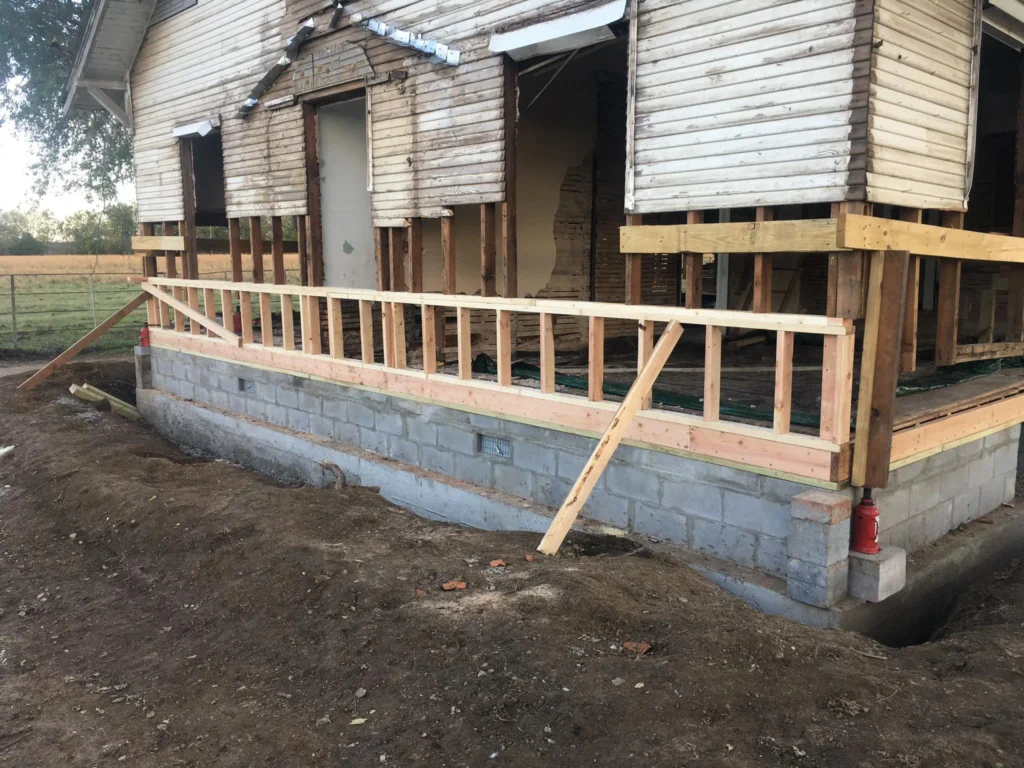
A home’s foundation is its most critical structural component. It supports the entire building and helps maintain stability over time. However, not all foundations are created equal—different types have unique designs, strengths, and vulnerabilities. Understanding the common types of foundations and the problems they face is essential for homeowners who want to protect their investment and ensure long-term safety.
In this post, we’ll break down the three different types of foundations—slab, pier and beam, and basement—and provide useful maintenance tips to keep them in good condition.
1. Slab Foundations
What Is a Slab Foundation?
A slab foundation is a single, thick concrete pad poured directly on the ground. It serves as both the floor and the base for the structure. Slab foundations are common in warmer climates with stable soil because they are quick and cost-effective to build.
Common Problems with Slab Foundations
- Cracking: Slabs can develop cracks from shrinkage, temperature changes, or soil movement beneath the concrete. Small cracks are often cosmetic, but larger ones may signal serious structural issues.
- Settling and Sinking: If the soil under the slab compacts unevenly or erodes, parts of the slab can sink or settle, causing uneven floors or wall cracks.
- Moisture Intrusion: Because slab foundations are close to the ground, they can be prone to moisture problems, especially if the soil drainage is poor.
- Plumbing Issues: Plumbing pipes embedded in the slab can crack or leak over time, leading to costly repairs.
Maintenance Tips for Slab Foundations
- Inspect for Cracks: Regularly check for new or expanding cracks. Seal minor cracks promptly to prevent water infiltration.
- Improve Drainage: Ensure gutters and downspouts direct water away from the foundation. Consider grading the soil so it slopes away from your home.
- Control Moisture: Use vapor barriers under floors in humid areas and monitor indoor humidity levels.
- Watch for Uneven Floors: Uneven or sloping floors can indicate settling; get professional advice early to avoid costly repairs.
2. Pier and Beam Foundations
What Is a Pier and Beam Foundation?
Pier and beam foundations use concrete piers or wood posts set deep into the ground to support the building’s weight. Beams span between piers, creating a crawlspace underneath the home. This type of foundation is common in areas with expansive or unstable soil.
Common Problems with Pier and Beam Foundations
- Sagging Floors: Over time, wooden beams can sag or deteriorate, causing floors above to become uneven.
- Wood Rot and Pest Damage: Moisture buildup in crawlspaces can lead to wood rot and attract pests like termites or carpenter ants.
- Crawlspace Moisture: Poor ventilation or drainage can cause moisture accumulation, leading to mold and mildew.
- Foundation Shifting: If piers shift or sink due to soil movement, the foundation’s stability is compromised.
Maintenance Tips for Pier and Beam Foundations
- Regular Crawlspace Inspections: Check for signs of moisture, pests, or wood damage under your home.
- Maintain Proper Ventilation: Ensure crawlspace vents are open and unobstructed to reduce humidity.
- Install Vapor Barriers: A plastic vapor barrier on the crawlspace floor helps prevent moisture problems.
- Check for Sagging or Cracks: Monitor floors and walls for signs of shifting or settling and address issues quickly with a foundation specialist.
3. Basement Foundations
What Is a Basement Foundation?
Basement foundations involve digging a full or partial basement below ground level and constructing concrete or masonry walls to support the home above. Basements are common in colder climates where frost depth requires deeper foundations.
Common Problems with Basement Foundations
- Water Leaks and Flooding: Basements are susceptible to water intrusion through walls or floors due to poor drainage or cracked foundation walls.
- Cracking and Bowing Walls: Hydrostatic pressure from saturated soil can cause basement walls to crack, bow, or even collapse.
- Efflorescence: White mineral deposits on basement walls indicate water seepage and moisture problems.
- Mold and Mildew: Excess moisture creates a breeding ground for mold, which can damage building materials and affect indoor air quality.
Maintenance Tips for Basement Foundations
- Improve Exterior Drainage: Ensure gutters, downspouts, and grading direct water away from the foundation.
- Install or Maintain Sump Pumps: Sump pumps can remove accumulated water and prevent flooding.
- Seal Cracks Promptly: Use hydraulic cement or waterproof sealants on any visible cracks.
- Control Indoor Humidity: Use dehumidifiers and ensure proper ventilation to keep moisture levels low.
General Foundation Maintenance Tips
Regardless of your foundation type, here are some universal tips to help maintain your home’s base:
- Regular Inspections: Schedule annual foundation inspections with a trusted professional to catch issues early.
- Landscaping Care: Keep large trees and shrubs a safe distance from your foundation to prevent root damage and soil disruption.
- Monitor Plumbing: Leaking pipes or irrigation systems can saturate soil and weaken foundations, so keep plumbing in good repair.
- Address Issues Early: Foundation problems worsen over time, so don’t delay repairs when signs appear.
Conclusion
Your foundation is the literal foundation of your home’s safety and value. By understanding the differences between slab, pier and beam, and basement foundations, and knowing the common issues each faces, you can take proactive steps to protect your investment. Regular maintenance, proper drainage, and timely repairs will help keep your foundation solid for decades to come.
If you’re experiencing any foundation concerns or need a professional inspection, contact Rock Famous Foundation Repair. We serve homeowners across Oklahoma with expert foundation solutions tailored to your home’s unique needs.
